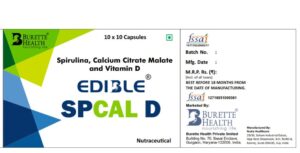Burevit D3 60K capsules (1×4) x 5 strips
Original price was: ₹687.50.₹542.00Current price is: ₹542.00.
Description
Burevit D3 60K capsules
A fat-soluble vitamin used by the body for normal bone development and maintenance by increasing the absorption of calcium, magnesium, and phosphate. A circulating level of 25-hydroxyvitamin D greater than 30 ng/mL is required to maintain a healthy level of vitamin D. Vitamin D deficiency can lead to an array of problems, most notably rickets in children and osteoporosis in adults. The fortification of milk with vitamin D in the 1930s was effective in eradicating rickets in the world. However, vitamin D deficiency is now more prevalent than ever and should be screened in high-risk populations. Many conflicting studies are now showing an association between vitamin D deficiency and cancer, cardiovascular disease, diabetes, autoimmune diseases, and depression. Burevit D3 60K capsules should be taken orally as directed by the physician.
Vitamin D deficiency can result from several causes.
1. Decreased dietary intake and/or absorption.
Certain malabsorption syndromes such as celiac disease, short bowel syndrome, gastric bypass, inflammatory bowel disease, chronic pancreatic insufficiency, and cystic fibrosis may lead to vitamin D deficiency. Lower vitamin D intake orally is more prevalent in the elderly population.
2. Decreased sun exposure.
About 50% to 90% of vitamin D is absorbed through the skin via sunlight while the rest comes from the diet. Twenty minutes of sunshine daily with over 40% of skin exposed is required to prevent vitamin D deficiency. Cutaneous synthesis of vitamin D declines with aging. Dark-skinned people have less cutaneous vitamin D synthesis. Decreased exposure to the sun as seen in individuals who are institutionalized, or have prolonged hospitalizations can also lead to vitamin D deficiency. Effective sun exposure is decreased in individuals who use sunscreens consistently.
3. Decreased endogenous synthesis.
Individuals with chronic liver disease such as cirrhosis can have defective 25-hydroxylation leading to deficiency of active vitamin D. Defect in 1-alpha 25-hydroxylation can be seen in hyperparathyroidism, renal failure and 1-alpha hydroxylase deficiency.
4. Increased hepatic catabolism.
Medications such as phenobarbital, carbamazepine, dexamethasone, nifedipine, spironolactone, clotrimazole, and rifampin induce hepatic p450 enzymes which activate degradation of vitamin D.
5. End organ resistance.
End organ resistance to vitamin D can be seen in hereditary vitamin D resistant rickets.
Vitamin D deficiency
It is a global public health issue. About 1 billion people worldwide have vitamin D deficiency, while 50% of the population has vitamin D insufficiency. The prevalence of patients with vitamin D deficiency is highest in the elderly, obese patients, nursing home residents, and hospitalized patients. The prevalence of vitamin D deficiency was 35% higher in obese subjects irrespective of latitude and age. In the United States, about 50% to 60% of nursing home residents and hospitalized patients had vitamin D deficiency. Vitamin D deficiency may be related to populations who have higher skin melanin content and who use extensive skin coverage, particularly in Middle Eastern countries. In the United States, 47% of African American infants and 56% of Caucasian infants have vitamin D deficiency, while over 90% of infants in Iran, Turkey, and India have vitamin D deficiency. In the adult population, 35% of adults in the United States are vitamin D deficient whereas over 80% of adults in Pakistan, India, and Bangladesh are Vitamin D deficient. In the United States, 61% of the elderly population is vitamin D deficient whereas 90% in Turkey, 96% in India, 72% in Pakistan, and 67% in Iran were vitamin D deficient.
Vitamin D plays a crucial role in calcium homeostasis and bone metabolism. With chronic and/or severe vitamin D deficiency, a decline in intestinal calcium and phosphorus absorption leads to hypocalcemia leading to secondary hyperparathyroidism. This secondary hyperparathyroidism then leads to phosphaturia and accelerated bone demineralization. This can further results in osteomalacia and osteoporosis in adults and osteomalacia and rickets in children.
Burevit d3 is Indicated in various Indications
Vitamin d deficiency
Osteoarthritis
Osteoporosis
Osteomalacia
Rickets
rheumatoid arthritis
chronic kidney disease
Nephrotic syndrome
Tuberculosis
Viral including covid
Bacterial pneumonia
Bronchial asthma
hepatic failure
malabsorptions
Diabetes mellitus
Syndrome x
hypothyroidism
Hyperthyroidism
medications –
Vit d is supplemented along with – anti seizure medication
– glucocorticoids
-rifampicin
– HAART
low maternal vitamin d in pregnancy has been associated with reduced cognitive functions and changes in glucose and insulin concentration in offsprings leading to risk of diabetes .
You may also like…
-
- Sale!
- Immune booster
Edible® SPCAL-D Immune booster (100 capsules)
- Original price was: ₹2,950.00.₹2,750.00Current price is: ₹2,750.00.
- Add to basket




Reviews
There are no reviews yet.